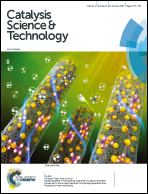Hierarchical TiO2 nanonetwork–porous Ti 3D hybrid photocatalysts for continuous-flow photoelectrodegradation of organic pollutants†
Abstract
Photocatalysis is an efficient approach for the degradation of organic pollutants, and continuous-flow photodegradation has advantages compared to general photocatalysis, which uses powder photocatalysts. Herein, we present a novel three-dimensional (3D) micro-nano hierarchical photocatalyst, TiO2 nanonetwork–powder metallurgical porous titanium hybrid material (TiO2/porous Ti), for continuous filtration photocatalysis/photoelectrocatalysis prepared through a hydrothermal-based chemical method. A photocatalytic layer of 3D TiO2 nanowire networks self-assembled on the surface of metallic porous Ti channels to form TiO2/porous Ti. The interconnected TiO2 thin nanowire networks with anatase–rutile bi-phases introduce a photocatalytic layer with a high photocatalytic performance. The porous structures and wire-like morphology of metallic titanium can enhance photo-induced carrier transport and separation, and it can act as a 3D electrode for photoelectrocatalysis. A novel continuous-flow photocatalytic reactor was designed by setting a group of TiO2/porous Ti sheets vertically in a quartz box equipped with ultraviolet light-emitting diodes (UV-LEDs). By applying a 0.6 V low electrical bias between the TiO2/porous Ti electrodes and a Pt wire electrode, a device with one layer of TiO2/porous Ti can result in 90% degradation of methyl orange (MO) under acidic conditions with 110 mW cm−2 of UV irradiation over 40 min; a device with three layers of TiO2/porous Ti needs just 10 min to reach the same photodegradation efficiency. The continuous degradation of other model pollutants, Rhodamine B (Rh B) and methylene blue (MB), was also demonstrated for this TiO2/porous Ti hybrid photocatalyst also with high photoelectrocatalytic efficiency. A continuous-flow photoelectrocatalytic reactor equipped with TiO2/porous Ti shows potential for the treatment of water in environmental protection applications.



 Please wait while we load your content...
Please wait while we load your content...